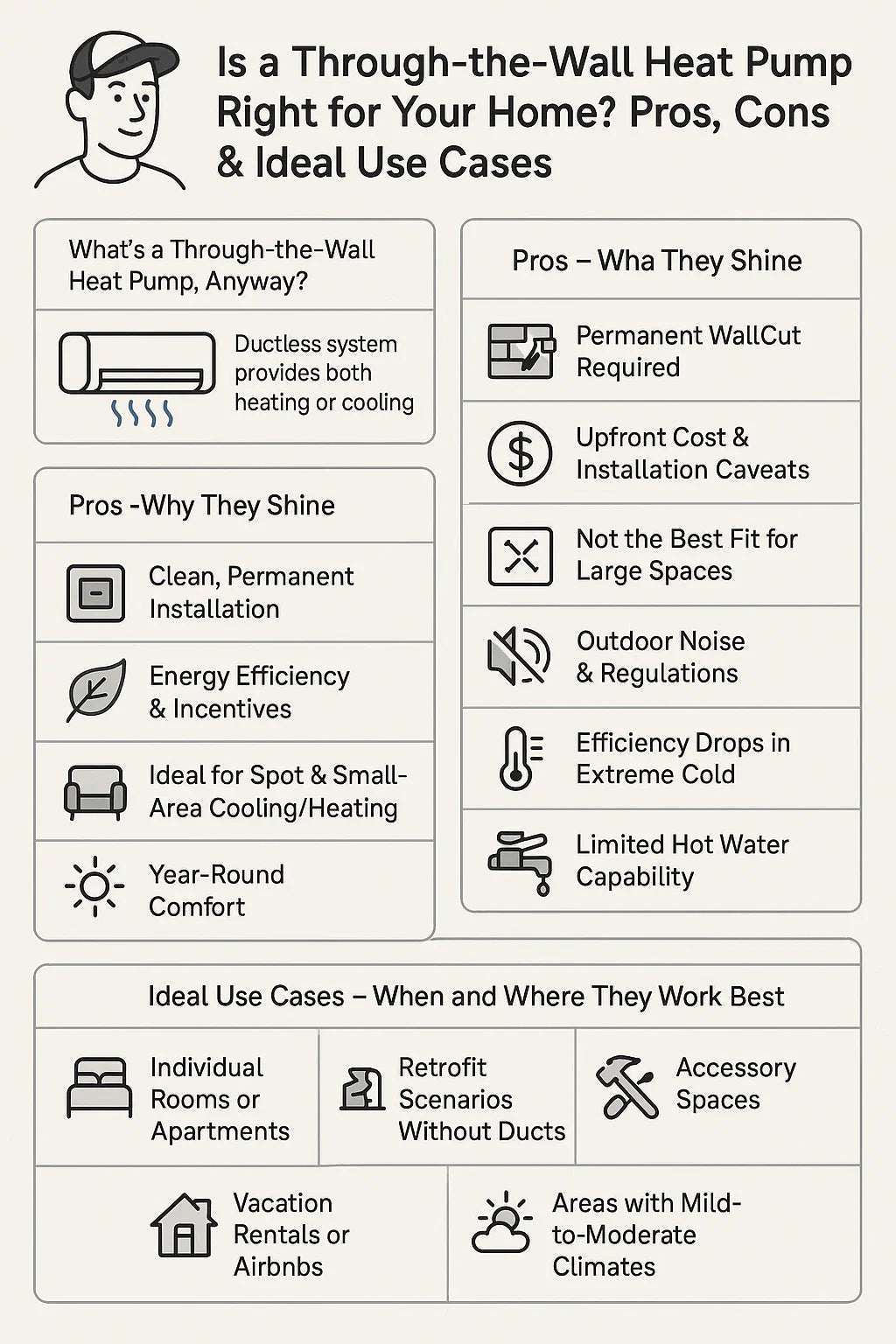Introduction: Jake’s Journey
Hey there – Jake here. When I first stumbled upon through‑the‑wall heat pumps, I was intrigued. Could this compact, efficient unit be the smart swap for my old window AC and patch‑job heater? I wanted real pros, real cons, and the best use cases laid out clearly. So, here's the build‑it‑yourself guide—as honest and helpful as if I were explaining over a coffee at the workshop.
What’s a Through-the-Wall Heat Pump, Anyway?
A through‑the‑wall heat pump is a self‑contained, ductless system fitted into a cut‑out in your exterior wall—no clunky window unit or whole‑house HVAC required. It slides into a framed rectangle, with a sleeve that stays year‑round, and delivers both heating and cooling.
Energy Efficiency & Performance
These units often achieve impressive COPs (Coefficient of Performance)—typically around 3–5—meaning they deliver 3 to 5 units of heat per 1 unit of power used, far better than traditional resistance heaters. Wikipedia
Pros – Why They Shine
1. Clean, Permanent Installation
No more blocking windows or wrestling with window brackets. The unit sits flush, looking neat and integrated. No lugging it out in winter or storing it.
2. Quiet Indoor Operation
Because the compressor lives outside, the indoor noise drops significantly—often under 60 dB. You get cooling or heating without feeling like you're camped beside a jet engine.
3. Energy Efficiency & Incentives
High efficiency means lower bills—and many models are ENERGY STAR® certified. In some regions, that qualifies you for rebates or tax credits.
4. Ideal for Spot & Small-Area Cooling/Heating
If your goal is to cool or warm a single room, studio, or sunroom, this is one of the most cost-effective HVAC routes. No need to cool the whole house when you’re just living in one space.
5. Year-Round Comfort
These units don’t just cool—they reverse to heat. You get both modes in one compact package.
6. Flexible, Efficient Design
Great for rentals, vacation homes, garages, or small offices. They’re relatively easy to install and maintain compared to more complex systems.
The Guide to Through-Wall AirSource Heat Pumps
Cons – What’s Not So Great
1. Permanent Wall Cut Required
You’ve got to cut a hole in your exterior wall, potentially impacting curb appeal or resale—unless it's done cleanly and professionally
2. Upfront Cost & Installation Caveats
Installation isn’t always plug-and-play. You may need structure modification, precise sealing, and sometimes professional install to avoid leaks or inefficiency. Costs are higher than window units.
3. Not the Best Fit for Large Spaces
One unit typically handles up to ~700 sq ft. If you're trying to tackle multiple rooms or a large open plan, you'll need more than one unit, or a different HVAC approach.
4. Outdoor Noise & Regulations
The compressor and fan outside can be noisy—especially at night. Some areas regulate noise levels or require noise assessments before installation.
5. Efficiency Drops in Extreme Cold
Air-source models become less efficient when temperatures plunge. You might need auxiliary heat or a hybrid system for extremely cold climates.
6. Limited Hot Water Capability
Typically, through-wall air-to-air units don’t supply hot water. If heating water is part of your needs, you'd need a separate solution.
Ideal Use Cases—When and Where They Work Best
• Individual Rooms or Apartments
Great for living rooms, sunrooms, bedrooms, or small apartments—where you just need efficient, zoned climate control.
• Retrofit Scenarios Without Ducts
In homes without ductwork, this offers cooling and heating without tearing through walls.
• Accessory Spaces
Garages, workshops, in-law suites—any spot you don’t heat or cool all day, but pop into occasionally.
• Vacation Rentals or Airbnbs
Monthly guests would appreciate quiet, efficient control—but owners avoid the hassle of window units or centralized controls.
• Areas with Mild-to-Moderate Climates
Works great where winters aren’t brutal—and summers mean you want some A/C without full ducted systems.
Real-World Checklist: Is It a Fit for YOU?
| Ask Yourself | Yes? If… |
|---|---|
| Need for dual-mode (cooling + heating)? | You want year-round use from one device |
| Size of space | Under ~700 sq ft |
| Walls and layout allow for modification? | Yes—solid wall, manageable installation |
| Noise concerns? | Outdoor placement is acceptable |
| Resale impact? | You’re okay with a permanent wall addition |
| Budget constraints? | Willing to pay upfront for long-term efficiency |
| Hot water needs? | You have a separate system or solution |
Jake’s Final Take
So, is a through-the-wall heat pump your next home upgrade? If you’re targeting one room or small living space, crave quiet efficiency, don’t mind installing a wall sleeve, and you're okay managing something more permanent—the answer is probably yes. You get heating and cooling in one sleek, space-saving unit—and long-term savings to boot.
If you're heating the whole house, need hot water, or live in bitter cold climates, you may want to explore central systems, ground-source options, or hybrid setups.
Want help sizing your space, evaluating models, or planning install next steps jazzed up with Jake’s “measure-twice, install-right” checklist? Just say the word—I’m here to walk through it with you.
In the Next Topic we will know more about: How to Size a Through-the-Wall Heat Pump: BTUs, Room Size & Climate Tips







